|
 Eichleriella spinulosa Eichleriella spinulosa
SynonymsRadulum spinulosum
BiostatusPresent in region - Indigenous. Non endemic
Images (click to enlarge)
Owner: J.A. Cooper | 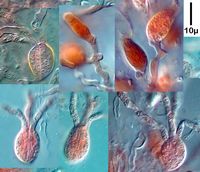
Caption: basidia (congo red)
Owner: J.A. Cooper | 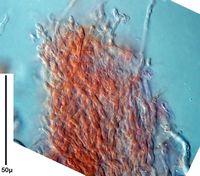
Caption: hyphal peg/spine (congo red)
Owner: J.A. Cooper | 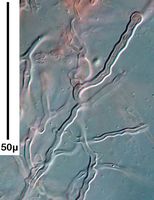
Caption: thick walled hyphae
Owner: J.A. Cooper | 
Caption: spores (congo red/NH4OH)
Owner: J.A. Cooper | 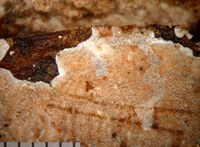
Owner: J.A. Cooper | 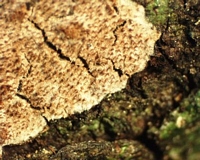
Caption: Eichleriella spinulosa, BCP 1734
Owner: B.C. Paulus |
Article: McNabb, R.F.R. (1969). New Zealand Tremellales - III. New Zealand Journal of Botany 7(3): 241-261 (http://www.rsnz.org/publish/abstracts.php).
Description: Fructifications arid when fresh, drying coriaceous,
resupinate, at first orbicular or circular, often becoming confluent, forming
irregular areas to 15 cm in longest dimension, sordid white, cream, or more
typically greyish-brown or brownish-beige, often with faint pinkish tints when
fresh, changing little on drying, bearing hyphal pegs; margins paler than hymenial
surface, tomentose, adnate when young, often slightly reflexed when old, free
from pegs. In section to 450 µm thick, consisting of pegs, basal layer and hymenium;
structure monomitic. Pegs acute, sterile except occasionally at extreme base,
concolorous with or darker than hymenial surface, projecting to 200 µm, composed
of interwoven, rather thick-walled, tinted hyphae. Basal layer poorly defined,
composed of interwoven, repent, thick-walled, tinted hyphae, 3-5 µm diam. Hymenium
composed of dikaryophyses and basidia; dikaryophyses simple or sparingly branched
apically, thick-walled throughout or thinner walled and slightly inflated apically,
heavily crystal encrusted, tinted; probasidia broadly cylindrical to clavate,
proliferating through basal clamp connections, 17-33.5 x 7.8-12.5 µm, becoming
longitudinally cruciate-septate, longitudinal septa diverging basally to delimit
inflated apical portion from stalk; sterigmata cylindrical, to 65 x 3.5 µm.
Basidiospores curved-cylindrical to allantoid, hyaline, apiculate, 12.4-18.2-(20)
x 5.8-7.8 µm. Germination by repetition, or by stout germ tubes.
Habitat: Angiosperm or gymnosperm bark and wood.
Notes: In recent years there has been some controversy
as to the identity of Eichleriella spinulosa. New Zealand collections
agree closely with Reid's (1957) description of the species and with collections
at Kew (D. A. Reid, pers. comm.). Reid (1957) considered the European fungus
commonly identified as E. spinulosa to be a distinct species, E. deglubens
(Berk. & Br.) Lloyd. He distinguished E. spinulosa by the narrower
spores, smaller basidia, and cylindrical to broadly ovate, as opposed to strongly
clavate, probasidia. Donk (1966) tentatively adopted Reid's interpretation of
E. spinulosa but Wells (1961) could not find any significant differences
between European and American specimens and regarded E. deglubens as
a synonym. The large clavate probasidia in which the fertile apical portion
becomes separated from the stalk by diverging longitudinal septa are characteristic
of this species. It appears that the considerable variation in the length of
basidia as described by various authors is due to differences in interpretation
of the basidium. The measurements given above are of the entire probasidium
from the basal clamp connection, and are considerably shorter than those given
by Wells (1961) for the same structure.
As pointed out by Olive (1958), it is difficult
to distinguish between E. spinulosa and certain species of Heterochaete
such as H. delicata (Klotzsch) Bres. and H. livido-fusca Pat. Wells (1961)
recognised that Eichleriella was an artificial genus as currently interpreted,
and transferred the type species to Exidiopsis. At the same time, he
distinguished a group of species consisting of the three above named and Protohydnum
cartilagineum Moll., which possessed spinose basidiocarps of essentially
the same texture and a similar basidial morphology. It seems likely that when
more information is available, this group will be accorded generic rank.
Eichleriella spinulosa is characterised by the arid spinose fructifications, thick-walled
internal hyphae, crystal encrusted dikaryophyses, and clavate, stalked basidia.
It has not previously been recorded from New Zealand.
|